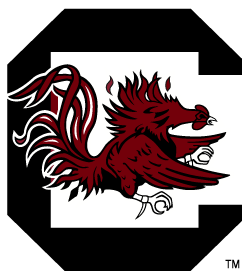Nov. 24, 2003
by Tom Price, Gamecock Historian
Harold Green came from a military family, the son of a career Air Force man, and saw a lot of the world before the family settled in Summerville and Harold became a football star at Stratford High School in nearby Goose Creek.
When he was six years old the family moved to Japan and lived in Tokyo for two years. He is the second oldest of five siblings with three brothers and one sister.
Harold spent a year in the Philippines and three years in Panama in addition to some stateside duty stations. His father, Harold, Sr., retired after more than 21 years in the Air Force and the family settled permanently in Summerville.
Green came to the University of South Carolina as a freshman in 1986 and compiled an outstanding four year career with the Gamecocks before moving on to a nine year National Football League career with the Cincinnati Bengals, St. Louis Rams and Atlanta Falcons. He received a Bachelor of Science degree in Retail Management in 1989.
After professional football Green returned to South Carolina and Columbia where he is a partner, with three other former Gamecock football stars, in an automobile dealership named Pro Bowl Motors.
Otis Morris is president of the company and other investors include Green, Sterling Sharpe and Gerald Dixon. Morris played for the Gamecocks, 1982-86, Sharpe 1983-87, and Dixon 1990-91. Sharpe went on to stardom with the Green Bay Packers before a career as a television analyst and Dixon played in the NFL with Cleveland, Cincinnati and San Diego. He and Green were teammates with the Bengals.
“We sell about 25 cars a month,” Harold says, “and are doing all right.” In addition to being an investor he is active in the business but also finds time to work part time for his alma mater with the Carolina Resources Student Services, the academic support service for student athletes.
Green “married his high school sweetheart”, Andrea, and the couple has three daughters, ages fifteen, nine and “the baby is three.”
At Carolina, Green scored a school record 15 touchdowns in 1987, his sophomore season. He shares the career touchdown record with 1980 Heisman Trophy winner George Rogers. They each scored 33 career touchdowns.
Green carried the football 702 times during his Carolina career for 3,005 yards, a four-year average of 4.3 yards per rush. His 3,005 yards ranks third on Carolina’s all time career list behind Rogers, 1977-80, and Brandon Bennett, 1991-94.
Harold also caught 94 passes for 859 yards. The 94 receptions are 10th on Carolina’s all time list. His best receiving day was seven receptions against Louisiana State in 1987 and his longest catch was 56 yards from quarterback Todd Ellis against Nebraska in 1986.
Green rushed for more than 100 yards 10 times during his Carolina career with his best being 172 yards against Wake Forest in 1987. He also had triple digit rushing games against Duke, Georgia Tech, Virginia, Virginia Tech, N. C. State, Miami (Fla.), Clemson and twice against Western Carolina.
He topped the 1,000-yard mark in 1987 with 1,022 and ended his collegiate career with 989 yards in 1989. His rushing total as a freshman was 388 yards and he had 606 yards in 1988.
Green played three seasons under Coach Joe Morrison and his senior year under Coach Sparky Woods, with records of 3-6-2, 8-4, 8-4, and 6-4-1 for a career record of 25-18-3. The Gamecocks played in the Gator Bowl in 1987 and the Liberty Bowl in 1988.
In 1990 the Cincinnati Bengals drafted Harold Green in the second round, the 38th overall pick, and he began a nine-year NFL career.
He played six seasons, 1990-95, with the Bengals, was with the St. Louis Rams in 1996, and ended his career with two seasons, 1997-98, under another former Gamecock player, Coach Dan Reeves, with the Atlanta Falcons.
Green has a Super Bowl ring, as the Falcons, under Reeves, advanced to the NFL title game in 1998. He was selectly to play in the NFL Pro Bowl in 1992.
Harold Green was inducted into the University of South Carolina Athletic Hall of Fame in 2002.












